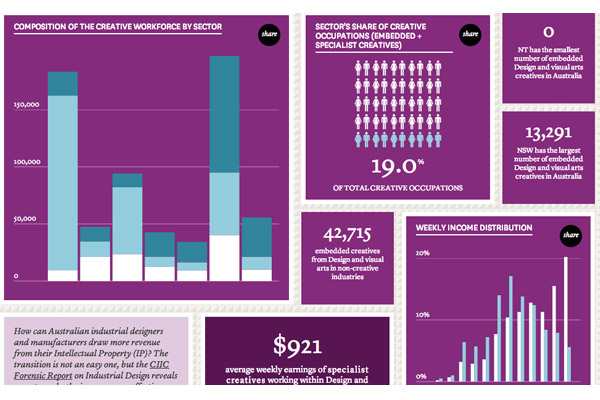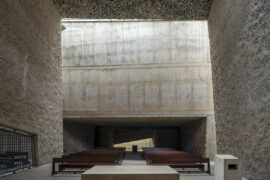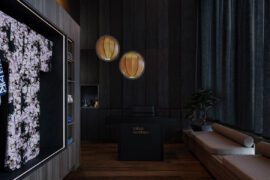A new report, Valuing Australia’s Creative Industries, released today by the Australian Government’s Creative Industries Innovation Centre (CIIC), measures the economic value of the Architecture and Design & Visual Arts sectors.

February 18th, 2014
According to the report, there were 95,000 people in the Design & Visual Arts workforce and 47,000 people in the Architecture workforce in Australia in 2011.
There were 22,397 businesses in the Design & Visual Arts sector – which includes graphic, fashion, interior, industrial and jewellery designers as well as photography and commercial art services – in 2011.
The Architecture sector – which covers architectural, drafting, landscape and town planning services – is highly specialised. It is the only segment of the creative industries in which over 30% of the workforce consists of specialist workers (as opposed to administrative and support workers). In fact, over 70% of the 47,000 workforce are specialist workers.
Architecture professionals are increasingly sought after beyond the creative industries: one quarter of the total workforce (12,373) are employed by non-creative industries.
The average weekly earnings of specialist creatives working within the Architecture sector is $1,107, while architecture professionals embedded in non-creative sectors have average weekly earnings of $1,234. Around 15% of the workforce earns more than $2,000 per week.
Design professionals are also highly sought after by non-creative industry employers. Of the 95,000 workforce, 58,000 (62%) are “embedded workers” employed across a range of other creative and non-creative industries, with over 10,000 designers working in the manufacturing industry alone. This demonstrates growing demand for Design & Visual Arts expertise.
The average weekly earnings of specialist creatives working within Design & Visual Arts is $921, while the average weekly earnings of professionals embedded within non-creative industries is $953. Only 5.6% earn $2,000 or more per week.
Average weekly earnings are lower in Design & Visual Arts than several other creative sectors (such as Software Design & Interactive Content; Advertising & Marketing; and Architecture). However, the incomes of creative industry professionals overall is significantly higher than those employed within other industries.
Valuing Australia’s Creative Industries also offers insight into the performance of Australian architecture businesses:
– 26.5% of businesses turnover less than $50,000 per annum
– 43.5% turn over between $50,000 and $200,000 per annum
– 26.5% turn over between $200,000 and $2 million
– 3.5% turn over more than $2 million per annum
And for Businesses in the Design and Visual Arts Sector:
– 40.7% of businesses turn over less than $50,000 per annum
– 35.9% turn over between $50,000 and $200,000 per annum
– 21.4% turn over between $200,000 and $2 million
– 2.0% turn over more than $2 million per annum
Creative Industries Innovation Centre Creative Industries Innovation Centre creativeinnovation.net.au
INDESIGN is on instagram
Follow @indesignlive
A searchable and comprehensive guide for specifying leading products and their suppliers
Keep up to date with the latest and greatest from our industry BFF's!

From the spark of an idea on the page to the launch of new pieces in a showroom is a journey every aspiring industrial and furnishing designer imagines making.

In an industry where design intent is often diluted by value management and procurement pressures, Klaro Industrial Design positions manufacturing as a creative ally – allowing commercial interior designers to deliver unique pieces aligned to the project’s original vision.

Merging two hotel identities in one landmark development, Hotel Indigo and Holiday Inn Little Collins capture the spirit of Melbourne through Buchan’s narrative-driven design – elevated by GROHE’s signature craftsmanship.

Motorwagen, designed by KP Architects, is a finely tuned venue with materials, craftsmanship and detailing inspired by Mercedes Benz.
Moooi are presenting a range of furniture and lighting in Milan, with a group of French maids keeping things clean around the stands.
CIBO Design has recently launched a brand new website created with the design savvy market in mind. “Our new website provides enhanced access to CIBO product information, services and resources,” said Co-Founder and Designer, Darrin Ingleton, CIBO Design. “A clearer structure, simplified navigation, improved search functions and a stunning array of inspirational images make finding […]
The internet never sleeps! Here's the stuff you might have missed

The World Architecture Festival has named The Holy Redeemer Church and Community Centre of Las Chumberas in La Laguna, Spain as World Building of the Year 2025, alongside major winners in interiors, future projects and landscape.

Making a splash on the hair spa scene, the latest project from X + O makes a little slice of Japan right at home in suburban Melbourne.